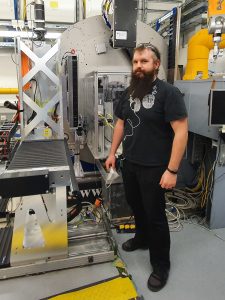
Congratulations to Niels Lefeld on winning one of the STOE Lightning Talk Awards of the 30th Anuual Conference of the DGK for his research with the topic Topochemical conversion of layered tungstates: an in-situ Raman spectroscopy and total scattering study. Niels is a PhD student in the Solid State Chemical Crystallography Group of Prof. Thorsten M. Gesing at University of Bremen. He already joined the group at the end of his Bachelor studies in Chemistry and Physics for his thesis about nanostructured titania. During his master studies in Chemistry, he further worked in the group and focused on powder synthesis and diffraction methods but also started on instrumental design and solving the engineering related problems in scientific research, which he thoroughly enjoys. As such, in his masters thesis he dived into mechanical construction and electronics, built a centrifuge prototype and dealt with the challenges of directed sedimentation of nanoparticle suspensions. Currently, he is compiling his results and finishing up his PhD thesis on structure, disorder and thermal behaviour of layered tungstates, which involves a variety of in/ex-situ and non-ambient measurement techniques.
His research interest lies predominantly within materials with different dimensionalities (e.g. nanoparticles, layered and network structures), their varying degrees of structural ordering and resulting properties. Apart from that he is interested in the digital aspects in scientific research, such as data literacy, infrastructure and programming.
Does the poster represent the full extent of your work or is there even more about it – for example a greater context inside the team?
My presented research is just one part of my PhD project. The main goal was the structure solution of a hydrotungstate, which turned out to be very tricky. High amount of disorder and only few information from X-ray powder diffraction made the use of ancillary probes and techniques (e.g. neutron scattering, PDF analysis etc.) necessary to get a full picture. In addition, the thermal behavior of the hydrotungstate and related compounds are part of the project. I developed the whole concept of the PhD project by myself- which retrospectively came with pros and cons, ups and downs. Nonetheless a formative experience for which I am grateful and very proud of.
What was the most exciting moment of your research so far?
Definitely the synchrotron beamtime at P21.1, DESY, with my colleagues Andrea and Mathias in October 2020. Due to the pandemic preventive measures, only the three of us were allowed to conduct the measurements. All of us were synchrotron first-timers, handling a new experimental setup over five days with 16h shifts – a heck of a ride, a clockwork-like team and tons of awesome data afterwards. It was stressful and exhausting but also super successful and a very rewarding experience. Props go out to our beamline contact Soham for bootcamping, helping out and being a fun guy.
What was your favorite part of the meeting?
Besides the interesting and diverse talks during the main conference, I very much enjoyed the Neutron Satellite Workshop. Unfortunately, the in-person tour of the FRM-II neutron source in Garching also couldn’t take place. Nonetheless, the very informative digital meeting included a broad overview about neutron properties and sources, several presentations dedicated to specific techniques ranging from scattering over imaging to spectroscopy as well as insights into current technological developments and scientific hot-topics. I can only recommend such events for beginners and advanced scientist alike – there’s always something in it for everyone.
